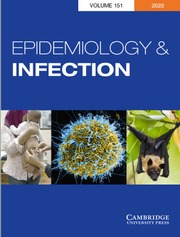Dear editor
We read with great interest the recent article by Healy et al. [Reference Healy1], which presents a compelling and rigorous model of the risk of Toxocara spp. transmission via food. By integrating qPCR and ELISA data into a Bayesian framework, the authors have significantly advanced our ability to quantify foodborne helminth risk – an area that has traditionally received far less attention than viral or bacterial foodborne hazards.
Strengths and contributions of the original study
The authors’ stratification of risks between spinach and undercooked meats offers a nuanced foundation for targeted public health messaging. This approach is particularly valuable given the established clinical burden of toxocariasis, which has been estimated to affect over 1.4 billion people globally [Reference Ma2]. Furthermore, by building on molecular and serological datasets and linking them with exposure estimates through dose–response modelling, the study sets a high standard for future food safety assessments involving zoonotic helminths.
Opportunities for contextual expansion
Several avenues for expanding the utility of this model deserve further consideration:
-
1. Cultural dietary patterns: The model’s impact would be magnified in regions where raw or lightly cooked food is more commonly consumed. For instance, Deng et al. reported substantially higher Toxoplasma gondii risk in pork consumers in China [Reference Deng3], highlighting the influence of preparation style on risk. In Southeast Asia, traditional dishes using raw pig liver or fermented meats could yield significantly higher risk estimates if incorporated into the Healy et al. framework.
-
2. Model parameter localization: While the authors have done well with UK-specific consumption and contamination data, adapting the model using local priors from high-risk settings could markedly change the risk output. Studies from Iran and Turkey documented contamination rates of unwashed vegetables with Toxocara eggs exceeding those used in this study [Reference Fallah4,Reference Erol5,Reference Abougrain6], indicating the need for localised calibration.
-
3. Diagnostic granularity: The assumption that seropositivity equates to viable larvae is understandable but could be refined with emerging techniques. The use of species-specific antigens—as proposed by Strube et al. [Reference Franssen7,Reference Strube8]—may allow future iterations of this model to distinguish risks associated with T. canis vs. T. cati, a distinction relevant to different food animal exposures.
Implications if adopted widely
If the suggestions above were integrated, the resulting model would be a powerful cross-contextual tool for:
-
• Food safety policy: Offering region-specific guidance for food washing, meat preparation, and consumer education.
-
• One Health surveillance: Supporting integrated parasite monitoring across livestock, produce, and environmental samples.
-
• Risk communication: Helping health authorities better communicate risks to vulnerable populations – particularly those consuming raw greens or undercooked meats.
Conclusion
Healy et al. have broken new ground in quantifying the hidden risk of foodborne Toxocara transmission. While the average risks may appear modest, the potential clinical severity and cultural variability in exposure warrant continued model expansion and validation. We commend the authors and hope this valuable work sparks further international research and policy engagement.
Data availability statement
No new data were generated or analysed in this correspondence.
Author contribution
Supervision: S.K.R.; Conceptualization: N.K.R.
Funding statement
This work received no specific grant from any funding agency, commercial or not-for-profit sectors.
Competing interests
The author declares no conflict of interest.


